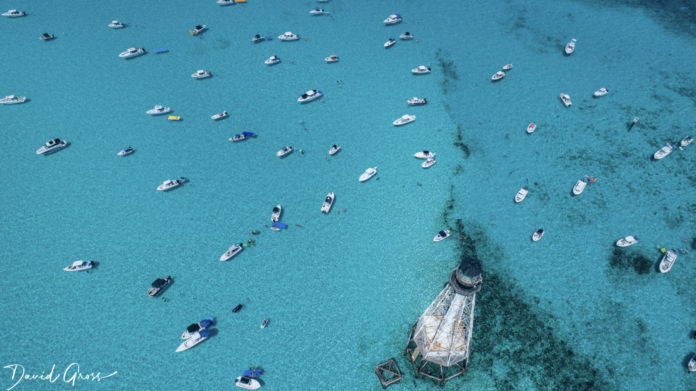
Florida Keys National Marine Sanctuary resources are under threat and facing continued deterioration. With threats of hurricanes and a stony coral tissue loss disease also came a boating boom during the COVID-19 pandemic that’s bringing more human interaction with the marine environment.
In a bid to counteract further resource decline, sanctuary officials are preparing to release an updated version of regulatory and management measures — through what’s known as the Restoration Blueprint — in June.
Florida Keys National Marine Sanctuary Advisory Council members received an update on the blueprint during a virtual meeting on April 19. Beth Dieveney, policy analyst for the sanctuary, said proposed boundaries and sanctuary-wide regulations are under review by agencies, including the National Oceanic and Atmospheric Administration (NOAA) and Offices of the National Marine Sanctuaries. Once that’s complete, a proposal will go out to the public for review and comment for a period of 90 days.
“We still do not have a definite date for release,” Dieveney said. “Our intent is to release it at a Sanctuary Advisory Council meeting.”
Sanctuary Superintendent Sarah Fangman said other agencies are reviewing the proposals relative to their own activities and regulations. She said the sanctuary is basically in a “wait-and-see” mode, but there’s hope that proposed rule changes will be released at the June 21 SAC meeting.
“They can raise questions or make suggestions. What they do or do not choose to offer at this state is totally out of our control,” Fangman said regarding the current review by other agencies. “That is why we are unable to be more explicit about timing. We have no idea what they may raise and what kind of consequences that could have to the timeline.”
Once updated regulations are released, sanctuary officials say they will host additional meetings, in-person and virtual — similar to a process that saw public input from the blueprint’s release in August 2019 to a public comment deadline in January 2020. There also will be opportunities to email input through regulations.gov.
In addition, Fangman said there will be some interactive tools on the sanctuary’s website to further understand what’s proposed.
Once released to the public, Fangman said nothing within the updated proposal will be changed during the feedback period.
“There’s no opportunity to slide something in while someone is out of town and not looking,” she said. “It is static and will stay exactly the same.”
Congress designated the Florida Keys National Marine Sanctuary on Nov. 16, 1990. Encompassing 3,800 square miles, the sanctuary protects open ocean, offshore reef tract and nearshore patch reefs, as well as seagrass meadows and fringing mangroves. The sanctuary is also home to maritime heritage resources that encompass a broad historical period.
A 2011 condition report on the sanctuary detailed declining water quality, habitats and key species due to coastal development, overfishing, vessel groundings and marine debris, among other factors. Since that report, the Keys experienced Hurricane Irma and an increase in boaters. A recent study by Bonefish & Tarpon Trust analyzed 93 South Florida bonefish for an average of seven pharmaceuticals in their systems. One fish had 17 pharmaceuticals.
It’s the first in-depth review of Florida Keys National Marine Sanctuary’s regulations and marine zoning approach since they were established in 1997. In the two decades since, the sanctuary said a lot has been learned about what management tools work and where improvements can be made.
With the release of the Restoration Blueprint in 2019 came a document with four alternatives. They proposed expanding several protected areas and revising restrictions for several others. Several new marine zones were also included in the various proposals.
Concerns were relayed over some proposed regulations and boundaries following the blueprint’s release. In Key West, concerns were raised during an October 2019 forum regarding changes to popular recreational areas such as Snipe Point and Marvin Key. The sanctuary emphasized in an informational brochure that “NOAA is not proposing to limit access to backcountry shallows and sandbars where there is historical recreational use, such as at Snipe Point and Marvin Key.”
Residential concerns were raised over proposed no-motor zones on the oceanside of Marathon, which runs from Vaca Cut to Tingler Island and is bisected by 10 channels.
In the Upper Keys, boaters expressed their displeasure during a forum over the idea of closing Carysfort and Sombrero reefs. Fangman admitted in her presentation that the original proposal was not clear about what “limited entry” meant with regard to local access. She said the absence of that language led people to conclude that “we meant to ban local people. And that’s not what we want at all. That’s not our intention.”

In addition to regulations and boundaries, there’s the sanctuary’s non-regulatory management plan. A separate document that’s independent of the proposals relative to boundaries, zones and regulations, Fangman said, the management plan contains a suite of activities from research to stewardship. She noted, however, that the plan is dependent on resources — namely funding — to make it happen.
In her remarks to the SAC, Fangman expressed excitement over President Joe Biden’s budget proposal, which includes $86.7 million for the Office of Marine Sanctuaries. That’s up from the $61 million the office received during the current fiscal year.
“The president is recognizing that the sanctuary system has been underfunded for some time now and additional resources are needed,” she said. “It goes a long way to make up for the shortfall we’ve had for many years.”
Fangman said priorities within the management plan represent some comments they heard time and time again during public input sessions after the blueprint’s release. They include enhancing law enforcement capabilities and tackling water quality issues.
Restoration, visitor use management, stewardship and engagement and management effectiveness were among the other priorities within the management plan.
Following comments from Fangman on the non-regulatory management plan, Capt. Will Benson, SAC member, said the management plan reflects “some good, careful listening” from comments made in previous meetings with the public.
“There’s responsiveness to the community in what we heard in those meetings,” he said.























